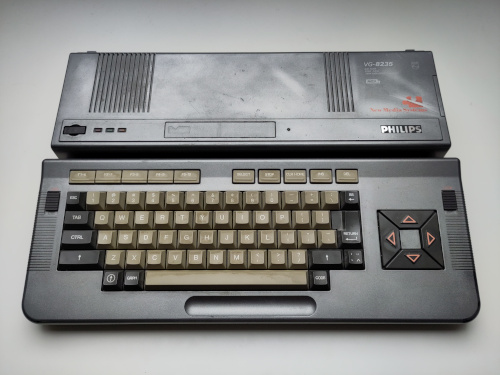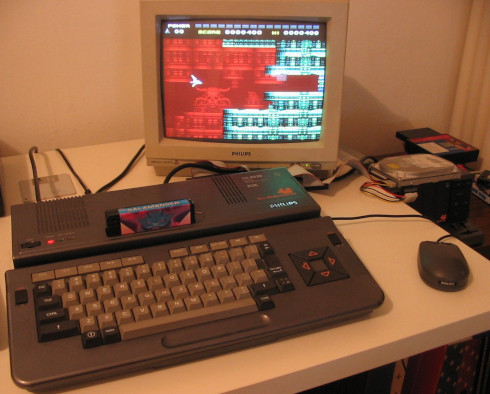My Philips VG-8235
April 29, 2024
The MSX2 standard (1985) differed from the original MSX standard (1983) on just a few points. MSX2 computers had at minimum of 64 kB RAM and 48 kB ROM with an updated BIOS and MSX-BASIC, a new backwards compatible video chip with at least 64 kB VRAM and a real-time clock. The CPU was still the 8-bits Zilog Z80 clocked at 3.5 MHz and the sound chip was still the three channel General Instrument AY-3-8910. Considering that in June of that year, Atari presented its ST line and in July that same year, Commodore presented its Amiga 1000 computer, one would have expected at least a 16-bit CPU, smooth scrolling in all directions and a sound chip with sample RAM.
Luckily, many MSX2 manufacturers, like Philips, produced computers with more than the minimum. 128 kB RAM and 128 kB VRAM was not uncommon, and the VG-8235, Philips’ second MSX2 computer, had a distinct Amiga/Atari ST form factor, with an internal disk drive, an RGB output port and two joystick ports on its right side. Combined with its 256 colours and multicolour sprites, it was a far cry from being an Amiga, but it really was a step-up from an already owned MSX1 computer. The VG-8235’s manual even calls the VG-8235 “the most versatile and most easy-to-use home computer existing today.” Quite a claim, considering it was launched in 1986, well after the Amiga 1000 and the Atari ST.

My VG-8235. The wear and tear is the result of an ill-prepared cleaning project by me.
But it wasn’t only the computer manufacturers who had little patience with the meagre update of the MSX standard. Konami, who had established a name for themselves with titles such as Knightmare, The Maze of Galious, Penguin Adventure, the Nemesis (Gradius) series and its spin-off Salamander, upped the game so to speak by adding a sound chip in their game cartridges with a much more grim sound. One of those games was Salamander, of which I had a second hand cartridge. I had a switch installed in it that allowed me to skip the game during boot so that Konami ROMs, loaded from disk, would be able to use its sound chip.
I bought my VG-8235 at an MSX fair in Tilburg in the south of the Netherlands, around 2000, plus or minus 2 years, I think. Anyway, this was the time I already used PCs for more serious work, but I was still heavily invested in my MSX games library. To collect the money for this machine, I had to sell my beloved NMS-8250. The reason I wanted this machine that badly, was that it had received a few upgrades. Its RAM had been expanded from 128 kB to 1 MB, a switch on the back would accelerate its CPU from 3,5 MHz tot 7 MHz, its single-density 360 kB disk drive had been upgraded to a double-density 720 kB drive and two RCA output ports, one for audio and one for video, had been added as well.

The picture above shows the backside of the VG-8235 with from left to right: the second cartridge port, the newly added CPU speed switch, an RF output port above the cassette tape interface, a Centronics printer port, a SCART output port left of a dedicated interface for a second disk drive, the two added RCA ports, above those an RGB output port. To the right of that is a power switch and an AC in. Including the RF output, the machine has four distinct ways to connect screens.

The right side of the VG-8235 shows the new beige but heavily discoloured disk drive above the two standard Atari joystick ports. Below the keyboard, you can see a tilt adjusting mechanism and room for it to be put more horizontally. Left and right of the keyboard were two slider buttons that allowed the user to adjust the tilt. This was a very considerate thing for time. Ergonomics almost always took a back seat behind design and production cost in home computers.

My Philips VG-8235 playing Konami’s Space Manbow (1989) using the sound chip in a modified Salamander cartridge
The VG-8235 originally came with two disks, one containing MSX-DOS1 and the other with Philips Home Office, an office suite. Mine didn’t, but I didn’t mind. I bought this machine to play games. These games were stored on a PC IDE hard drive. Sunrise, an MSX hardware manufacturer at the time, had produced IDE cartridges that contained an MSX-DOS2 ROM, which was what I used to connect that drive to the VG-8235. If you look closely at the picture above, you can see the hard drive sitting on to of a Philips NMS 1510 data recorder and its flat ribbon cable disappearing behind the VG-8235 right where its second cartridge slot is. That Molex connector that is feeding the hard drive is one that I ripped from an old PC power supply. I’m unsure why the mouse is in the picture.
Visible in the top right of the picture is a Philips NMS 1205 Music Module, a sound cartridge with MIDI IN/OUT/THRU connectors, RCA audio output, an internal microphone and a Yamaha Y8950 sound chip with 9 channels of FM synthesis and a 16Khz ADPCM channel with 32kB Sample RAM. Still no Amiga sound, but certainly a step in the right direction.
The original period, in which four generations of MSX computers were created and sold, ended in the first half of the nineties. The last professional MSX magazine in my country lasted until 1997, a year after msx.org was started. Around that time, I expected the platform to silently die with no more games, and certainly no more hardware, but I was content with the collection I had.
Categories: my-retro-gear
Tags: msx, msx2, konami, philips
CC-BY-SA 2006-2024 thefoggiest.dev













